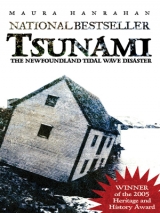
Текст книги "Tsunami"
Автор книги: Maura Hanrahan
Жанр:
История
сообщить о нарушении
Текущая страница: 12 (всего у книги 14 страниц)
24
Magistrate Malcolm Hollett was determined to fully document every single case from Mortier Bay in the north to the villages of the boot around to Fortune Bay on the other side of the peninsula. The town of Fortune had survived the tsunamivirtually untouched, but forty-three-year-old widower Edgar Hillier had seen his house ripped off its foundation and thrown onto a high rock; in addition, the home’s porch and an annex had been destroyed. Hillier was in poor health, was going blind, and had three children who depended on him.
On the other side of the peninsula in Mortier near Marystown, the waves washed John and Bridget Antle’s house off its foundation. It would have to be taken down and rebuilt… Hollett nearly cracked his pen as he spread the words across the page. Then he glanced at a map; Mortier was just the beginning.
In mid-December Hollett called a meeting of the Rock Harbour-Corbin Committee. He had made several trips down the coast and was fair bursting to talk of what he had seen. Although he was now the agent for the South Coast Disaster Committee, the magistrate wanted to show his closest neighbours that he had not forgotten them.
As snowdrifts piled up outside Hollett’s Burin house, three men walked up the path. Merchant Frank LeFeuvre came from Bull’s Cove. He was followed by Albert Grant of Corbin and Captain William Foote who came from Stepaside.
As the men settled into the parlour and were served tea by Hollett’s quiet little maid, the magistrate read his draft report on the district south of Burin.
The men nodded solemnly and Albert Grant spoke up.
“Make sure you mention that Joshua Mayo’s house is gone,” he offered. “His and Sophia’s. The first wave ripped the house off its foundation and broke away the porch. It tore great holes in the roof, too. Now there’s a big tribe of them homeless.”
Hollett picked up his pen and raised his bushy eyebrows.
“There’s the Mayo children,” Grant continued. “Morgan, Irene, and Daisy, and there’s the four Moulton orphans who live with them, Annie and Tryphena, and the boys, little William and Bert. They lost all their food and Josh’s Hubbard engine is badly damaged, too.”
“Sounds like a very sad case,” Hollett said grimly.
“It is,” Grant nodded. “Those orphans have been through enough already and now this. I believe the family is all split up because there are too many of them to be housed together. It must be hard on those poor children.”
After a minute, Hollett turned his attention to merchant Frank LeFeuvre.
“How did you make out in the tidal wave, Frank? Have you had a chance to assess everything yet?” he asked.
“Well, it was the business that was hurt,” LeFeuvre answered. “Not our home, thanks be to God. But LeFeuvre’s Trading Company took a hit—I’d put the damage at about twenty-one hundred dollars. It’s substantial for us.”
Hollett looked dour. “You’ll need to be back in business for the fishing season,” he said. “The fishermen will need that as much as you do. This brings me to my next topic. There’s been a generous response to our tragedy from all over the country and beyond. We very much need and appreciate all the help we can get. But now Christmas is coming and the New Year will follow. People’s attention will turn from the tidal wave. Besides, human nature being what it is, November 18 will fade from memory soon enough—as good as people are. We have to do something about this.”
He stopped and did a slow turn about the parlour as the men considered his words.
“We still need help,” Albert Grant said. “There’s so much to be done yet.”
Hollett continued. “Yes. So I propose a trip to St. John’s after Christmas to remind the government and the people of the city of our tragedy and the conditions we are still facing. I think that you three gentlemen should accompany me.”
Grant drew back, his eyes wide. LeFeuvre spoke up, “A capital idea, so to speak. A kind of speaking tour of the city.”
“It’s certainly needed,” said Captain Foote. “I don’t know if we’re the right men to go, but you’re on the right track.”
“You might want to bring representatives from farther south, where there’s even worse damage and grief,” Grant said.
Hollett’s face brightened. “Quite right!” he said. “Thank you for your support, gentlemen. We shall agree in principle to the idea and begin planning, then?”
He smiled at their nods.
On January 15, 1930 Magistrate Malcolm Hollett and fisherman Albert Grant sat in the editorial offices of The Daily Newson Duckworth Street in St. John’s. Hollett’s heavy-lidded eyes bored into the editors and stenographers as he listed off the devastation that the tidal wave had wrought: thirty-two houses destroyed; twenty-seven others badly damaged; 144 large dories and one hundred small dories wrecked; and twenty-seven trap boats smashed to pieces. The men around the table gasped as Hollett spoke. This was the first time they had heard the numbers in such blunt form.
“Our people have also lost much of their fishing gear,” Hollett said, speaking slowly. “Gone are forty-seven thousand cotton lines, a hundred and eight herring nets, ninety-four cod nets, thirty caplin seines, and three hundred and fifty six anchors.”
“That isa great deal of gear,” a burly, grey-haired man mused.
“It represents the livelihood of many men like Mr. Grant here,” Hollett said. “And some of the wealth of the country, as you can appreciate.”
“Rope,” Grant said. “We lost over forty thousand fathoms of rope of all sizes.”
“Yes,” said Hollett. “Keep in mind, gentlemen, that while we are most grateful for everything that has been done for us, the government is only taking care of public property. That is, government wharves will be rebuilt at public expense but family flakes and wharves will not. Our immediate requirements are for timber and sticks for wharves, flakes, and stages. We’ve received three carloads from Highland, on the west coast of the island, landed by steamer, and we were so pleased to get it. But, sadly, we need more. I’ve prepared a list of our needs.”
He handed a crisp piece of paper to eager hands. It read:
190,000 sticks for flakes
20,000 flake beams
10,000 wharf beams
13,000 flake longers
54,000 two inch planks
“We would be so grateful if your newspaper could publish this list,” he added. “It is difficult to distribute the goods we are receiving because so many places are without a wharf or landing stage—Lamaline, Point au Gaul, Taylor’s Bay. There’s only one private wharf at St. Lawrence. But efforts must be made regardless.”
Hollett noted the silence of the editors and how they stared at him. He continued.
“I cannot emphasize how important it is to get the fishermen outfitted for spring. The people of the South Coast are fishermen firstly and lastly and they need to be put in the same position they were in before the disaster.”
Albert Grant nodded. “Yes, we are fishermen. We want to fish.”
That day, the men of Taylor’s Bay put the finishing touches on Charles and Selina Hillier’s house, which had sustained fifty dollars worth of damage in the tidal wave, leaving it open on one side and exposed to the winter elements. Through the South Coast Disaster Committee, fifty thousand feet of lumber had been accumulated. A substantial portion of this had been brought to Taylor’s Bay, a priority as per the instructions of the medical staff who had visited on the Meigle.
After one of Charles’s neighbours hammered in the last nail, he said, “That’s it! She’s done and ready for you to move back into.”
Charles smiled and rubbed his hands in the January cold. He still had a lot of work to do—he had lost his three small boats, stage, and wharf—but this was a start. He looked across the meadow to see Selina and their children, Thomas, Bertram, Junior, Harold, and Freeman, the baby in her arms—his five fine boys. Before the tidal wave, Selina used to talk about wanting a girl; everyday she would tease him about it. Since November 18, she hadn’t mentioned the idea.
Behind her was Robert Bonnell, still ashen-faced from the loss of his wife and child to the waves. His three children came after him. The Bonnells would stay with Charles and Selina until the men of the village could build them a new house.
When the group reached the Hillier house, Selina turned to Robert and said, “This is your home now for as long as you like.”
Charles put his arm around his friend’s shoulder. Robert nodded and crossed the threshold, his little ones trailing after him. Charles and Selina looked at each other. “Poor Robert. I’m so glad we have each other,” she said, giving her husband’s hand a squeeze. Then she looked into his eyes and smiled shyly.
“Maybe we’ll have that girl one day,” she said.
That night in Point au Gaul, David Hipditch lay straight as a board in bed, staring at the plastered ceiling as he usually did until sleep finally overtook him in the wee hours just before dawn. The house– not his own, which was at the bottom of the sea somewhere—was full of people, but there seemed to be some kind of cotton gauze between him and everyone else. All his energy went into keeping it well hidden and showing appreciation for the kindness his in-laws, Nan and her family, were showering on him and Jessie. The faces of his and Jessie’s drowned children never left him: Thomas’ grin; Henry’s dancing eyes; little Elizabeth’s chubby cheeks. He cursed himself for the thousandth time for not being there to save them from the cruel water. He wished he could talk to Jessie but, though she lay at his side every night, her grief bathed her and there was no room for him in it. Since that awful night, she had barely registered his presence. As he did every night, David tried to pray.
Then he suddenly felt something warm at his shoulder—it was Jessie’s face rubbing against him. He turned and looked into her face. She was staring at him, her great brown eyes meeting his. He reached for her long hair and stroked it slowly. She continued to look at him.
“Jessie,” he whispered slowly. “I miss them.”
Then he cried quietly and she wrapped her arms around him and held him.
“Tell me you love me, Jessie,” he pleaded.
“Oh, David,” Jessie said. “I love you. I miss my babies, but I love you.”
“I need you,” David said.
“I’m sorry,” his wife answered. “I need you, too.”
David pulled Jessie close and they fell into a deep sleep in each other’s arms.
AFTERWORD
The 1929 quake originated about 250 kilometres or 153 miles south of the Burin Peninsula and travelled from the epicentre at the astonishing speed of eighty miles per hour. The waves hit the Burin Peninsula villages at sixty-five miles per hour. Although the most damaging by far, it turned out not to have been the first tsunamiin this part of the world. The first recorded earthquake occurred at Bonavista in 1775. On January 11, 1809, the entire Labrador coast was shaken by earth tremors. On November 30, 1836, people felt the earth rumble in Hopedale, Northern Labrador; at the same time, the air temperature rose considerably. Eight years later, the earth shook at Bonavista again, followed by fierce waves that rushed way inshore. Other earthquakes took place in 1857 in Northern Labrador, this time at Hebron, and in 1890 in St. John’s.
Except for reconstructed conversations, this book relies entirely on the historical record and on contributions from witnesses to the tsunami, some of whom corresponded with or were interviewed by Flanker Press or the author.
From Part One, young Anna Tarrant of Lawn never forgot the events of November 18, 1929, especially as it was her father’s birthday. Recognizing the danger for what it was, Anna’s father was responsible for getting many people in his community to safety. Anna grew up to marry an American and became Anna Contois. She wrote to us from her home in Barefoot Bay, Florida.
Mary Kehoe, of Red Head Cove, Conception Bay, who had been sailing to New York with her father, survived the voyage and later married an American. She wrote to us as Mary Dasting from Cape Coral, Florida.
Sam Adams, of Great Burin, who was eleven at the time of the tidal wave and felt the earth move in his garden, wrote to us from London, Ontario.
Bessie Hennebury, of Lord’s Cove, almost fifteen, was in her father’s fishing room helping to weigh dried fish, when the ground beneath her started to shake, scaring her out the door and up the hill to her home and the illusion of safety. Bessie married Bertram, the son of James Walsh, one of the rescuers of Margaret Rennie, the toddler who was trapped in the floating house with the bodies of her mother, brothers, and sister. Bessie spent her whole life in Lord’s Cove.
George and Ernest Pike were the enterprising young brothers of Burin Bay Arm determined to catch Mrs. Moulton’s sheep for twenty-five cents—in spite of the earth quaking beneath them. George is still living in Burin Bay Arm, while Ernest left home early during World War II and continued to sail in the foreign trade until he was transferred to the Abegweitin the Prince Edward Island-New Brunswick ferry service. He retired as Captain Ernest Pike and wrote to us from Summerside, PEI.
Austin Murphy, of Jersey Room, Lawn, was a seven-year-old boy when the waves gutted the villages of the Burin Peninsula in November, 1929. He had been taking a break from a soccer game when the ground first shook. A retired marine engineer, he wrote to us from Toronto.
Margaret Rennie, of Lord’s Cove, the toddler whose survival was considered miraculous when her mother and siblings died in their swept-away house, stayed with her aunt, Minnie Jackman, in Roundabout near St. Lawrence for awhile. Minnie was her late mother, Sarah’s, sister. Margaret’s brothers, Martin and Albert, stayed with friends. When Margaret was about five she was reunited with her brothers and her father, Patrick, and the family moved to Little St. Lawrence. Patrick went to work in the new fluorspar mines in nearby St. Lawrence and married a local woman. As an adult, Margaret became Margaret Saint and lived in Fox Cove, farther up the Burin Peninsula. There were no photographs of her mother, so she never knew what Sarah looked like.
Part Two recalls the myriad tragedies that befell Taylor’s Bay that singular night. There were almost a hundred livyers in the village in 1929. Although the majority of the houses were demolished by the tidal wave, the community seems to have recovered within a few years; by 1935, it had a population of 104, including two new families, the Pikes and the Chafes. After World War II, however, the village went into decline when people began to move away in search of year-round employment.
When I visited Taylor’s Bay on a bright fall day in 2003, the only sounds were made by black-backed gulls in search of food on the shore. Most of the few homes near the beach seemed deserted. The 2003/4 phone book lists only three families for Taylor’s Bay. But standing among the grasses that encircle the harbour it is not hard to imagine the boats, wharves, fishing rooms, clapboard homes, and people that once made this achingly beautiful place a community.
Also from Part Two, Nurse Cherry stayed in Lamaline until 1932, thus serving two full contracts with Nonia. Nonia’s 1932 Eighth Annual Report delivered at the organization’s headquarters in St. John’s read:
Nurse Cherry remains, as she has been from the first, our ‘high liner’ in number of patients treated and visits paid. She has given 624 treatments in the Dispensary and 1,305 in the homes, and paid the astonishing number of 6,153 visits. Her district reaches from Point Crewe on the West to Lord’s Cove on the East, a distance of eighteen miles. She answers many calls, also, which are long distances from her Centre, going as far as St. Lawrence. This would not be possible but for the motor car given to Nurse Cherry by an American gentleman following the reports of her work during the week of the tidal wave. This is Nurse Cherry’s second term with us, her third year. She has made many friends and done much splendid work in that time.
After the rebuilding operations were underway in the winter of 1929, Nurse Cherry went to St. John’s for a vacation. There she received many accolades, including a cheque for $250 from Dr. Mosdell on behalf of the Government of Newfoundland. In sending the cheque to Nurse Cherry, Mosdell wrote, “The whole Government feel that services such as yours should be signally and at the same time practically recognized.” Nurse Cherry was also awarded an engraved silver clock from the Nonia executive presented by Lady Middleton at a reception at Government House, the home of the governor.
During the summer of 1930 Nurse Cherry went home to England for a three month holiday. Her local committee back in Lamaline invited her to return and she assured them she would. In fact, she spent many years in Newfoundland, serving as district nurse in Heart’s Delight, and ending her career at the Markland Cottage Hospital, where she supervised a staff of nine. Mary Harris, who still lives in nearby Whitbourne, worked with Nurse Cherry as a food supervisor and housekeeper. Mrs. Harris remembers a large silver tray that the people of Lamaline had given to Dorothy after the tidal wave.
Although the two women liked each other, Mary describes Dorothy as a very private person. Indeed, an interesting postscript to the story of this enigmatic hero concerns her life in England prior to her arrival in Newfoundland. Despite the fact that almost all the newspaper accounts and most Nonia records refer to the nurse as Miss Cherry, Dorothy was a widow when she sailed across the Atlantic. Her husband may have been a soldier, as is implied in the preceding text.
In addition, Nurse Cherry seems to have had a daughter who would also have died young. Little information about Dorothy’s family is available (thus, I have had to make up a Christian name for her husband on page 95); according to our sources, she rarely spoke of her past or of home. Perhaps her work in Newfoundland served as a refuge of sorts for her:
I have been here for some time and have settled in with a garden, profusion of flowers and it seems like home. Markland Hospital is a very pretty one, for it is set back in a wooded land and has nicely kept flower beds. The hospital is built in the style of a bungalow and the rooms are painted in pastel shades. It has accommodation for 17 patients but there are times when beds have to be found for 27.
In 1947, Nurse Cherry was made a Member of the British Empire for her long years of nursing service in Newfoundland.
I am uncertain which unheralded local men accompanied Nurse Cherry on her post– tsunamijourney to the stricken communities. From the list of Lamaline residents, I chose Thomas Foote and Albert King, both young, relatively unencumbered, and not too badly affected by the tidal wave. The names of the local members of the relief communities, however, are from the historical record.
Prime Minister Richard Squires was in his second administration during the sad events of 1929. He was exonerated of charges (unrelated) of corruption during this term in an enquiry conducted by Governor Middleton (the same thing had happened during his first term). But the Great Depression and a crippling war debt caught up with the tiny country of Newfoundland and on April 5, 1932, ten thousand city residents rioted outside the Legislature—Squires, in disguise, barely escaped. The House was dissolved two months later and Squires’ Liberals lost the election.
Squires spent most of his time on his farm on the outskirts of the city and died in 1940 at the age of sixty.
From Part Three, Magistrate Malcolm Hollett later enjoyed a career in politics. He was elected to the National Convention, formed to debate Newfoundland’s post-war future at a time when the map of the world was being redrawn. Hollett favoured Responsible Government (roughly, independence) rather than Confederation with Canada. This battle was lost—fifty-two percent to forty-eight percent on a second referendum—but Hollett was elected to the House of Assembly in 1952 and became leader of the Progressive Conservative party the following year. In this capacity, he was leader of the opposition against Premier Joseph Smallwood, holding the position for several years. Hollett’s political career ended after ten years in the Canadian Senate.
Captain Dalton is the real name of the man who skippered the Meigle, the relief ship sent out by Squires’ government. However, so little information was available on him—his first name even seems to be lost to history—that I invented virtually everything else about him. The historical record shows that the relief team of the Meigleresponded quickly and generously to the dire needs of the people they encountered on their south coast trip; in addition, Dr. Mosdell had written that the captain had been particularly valuable to the relief team. Thus, I envisioned Dalton as a kind and generous man.
The Meiglewas in the passenger and cargo trade until the early 1930s. In 1932, at the height of the Great Depression, the ship became an auxiliary jail when the penitentiary in St. John’s turned out to be too small to hold the thousands of unemployed people who rioted over inadequate government relief. For eight months, the Meiglesat in the capital’s harbour, known as “the prison afloat,” fully staffed with prison personnel. It later returned to more conventional seagoing duties. Finally, after surviving several wartime close calls, in the summer of 1947, the Meiglewas wrecked at Marines Cove, losing her cargo of livestock, hens, and pigs. Her crew, however, survived.
Back on the Burin Peninsula, the body of fifteen-year-old Gertrude Fudge of Port au Bras was finally found in July, 1930 entangled in wreckage in the harbour bottom. Gertrude had drowned with her mother, Jessie, and two sisters, Harriet and Hannah, when the waves hauled their house out to sea; the other bodies had been found shortly after the tidal wave. The people of Port au Bras held a church service to remember the victims of the tidal wave on the sixty-fifth anniversary of the disaster ten years ago.
Magistrate Hollett decided to make special arrangements for the widow Lydia Hillier of Point au Gaul as her family had lost their breadwinner and their situation was unique. These arrangements are explained in Appendix Five.
Tidal wave victims were not compensated for lost winter provisions or their salted fish. Most of the monies paid were for house repairs, lost boats and the like. Not all gear was eligible for compensation. Anecdotally, at least, there is some evidence that many survivors were unhappy with the financial assistance rendered. While that is a topic for another book, perhaps, interested readers are referred to Tidal Wave, by Garry Cranford.
This book does not pretend to introduce all the heroes of the fall and winter of 1929. Many are already forgotten to history, but I hope that over the coming years other researchers and writers will turn their attention to this remarkable event in Newfoundland’s history.








